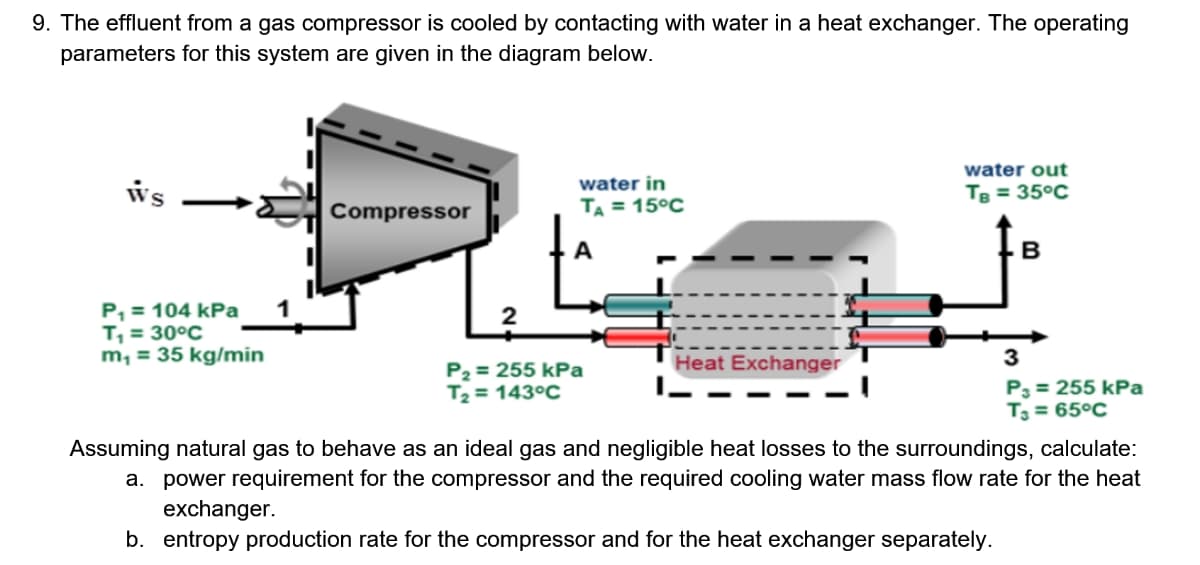9. The effluent from a gas compressor is cooled by contacting with water in a heat exchanger. The operating parameters for this system are given in the diagram below. water out water in ws Te = 35°C Compressor TA = 15°C P, = 104 kPa T, = 30°C m, = 35 kg/min 1 2 Heat Exchanger 3 P2 = 255 kPa T2 = 143°C P, = 255 kPa T3 = 65°C Assuming natural gas to behave as an ideal gas and negligible heat losses to the surroundings, calculate: a. power requirement for the compressor and the required cooling water mass flow rate for the heat exchanger. b. entropy production rate for the compressor and for the heat exchanger separately.
9. The effluent from a gas compressor is cooled by contacting with water in a heat exchanger. The operating parameters for this system are given in the diagram below. water out water in ws Te = 35°C Compressor TA = 15°C P, = 104 kPa T, = 30°C m, = 35 kg/min 1 2 Heat Exchanger 3 P2 = 255 kPa T2 = 143°C P, = 255 kPa T3 = 65°C Assuming natural gas to behave as an ideal gas and negligible heat losses to the surroundings, calculate: a. power requirement for the compressor and the required cooling water mass flow rate for the heat exchanger. b. entropy production rate for the compressor and for the heat exchanger separately.
Principles of Heat Transfer (Activate Learning with these NEW titles from Engineering!)
8th Edition
ISBN:9781305387102
Author:Kreith, Frank; Manglik, Raj M.
Publisher:Kreith, Frank; Manglik, Raj M.
Chapter7: Forced Convection Inside Tubes And Ducts
Section: Chapter Questions
Problem 7.49P
Related questions
Question
7

Transcribed Image Text:9. The effluent from a gas compressor is cooled by contacting with water in a heat exchanger. The operating
parameters for this system are given in the diagram below.
water out
water in
ws
TB = 35°C
Compressor
TA = 15°C
P, = 104 kPa
T, = 30°C
m, = 35 kg/min
1
Heat Exchanger
3
P2 = 255 kPa
T2 = 143°C
P3 = 255 kPa
T3 = 65°C
Assuming natural gas to behave as an ideal gas and negligible heat losses to the surroundings, calculate:
a. power requirement for the compressor and the required cooling water mass flow rate for the heat
exchanger.
b. entropy production rate for the compressor and for the heat exchanger separately.
Expert Solution
This question has been solved!
Explore an expertly crafted, step-by-step solution for a thorough understanding of key concepts.
Step by step
Solved in 2 steps

Knowledge Booster
Learn more about
Need a deep-dive on the concept behind this application? Look no further. Learn more about this topic, mechanical-engineering and related others by exploring similar questions and additional content below.Recommended textbooks for you

Principles of Heat Transfer (Activate Learning wi…
Mechanical Engineering
ISBN:
9781305387102
Author:
Kreith, Frank; Manglik, Raj M.
Publisher:
Cengage Learning

Refrigeration and Air Conditioning Technology (Mi…
Mechanical Engineering
ISBN:
9781305578296
Author:
John Tomczyk, Eugene Silberstein, Bill Whitman, Bill Johnson
Publisher:
Cengage Learning

Principles of Heat Transfer (Activate Learning wi…
Mechanical Engineering
ISBN:
9781305387102
Author:
Kreith, Frank; Manglik, Raj M.
Publisher:
Cengage Learning

Refrigeration and Air Conditioning Technology (Mi…
Mechanical Engineering
ISBN:
9781305578296
Author:
John Tomczyk, Eugene Silberstein, Bill Whitman, Bill Johnson
Publisher:
Cengage Learning